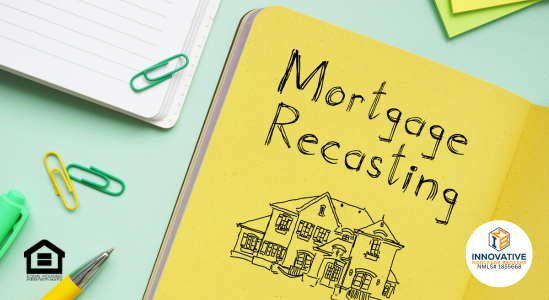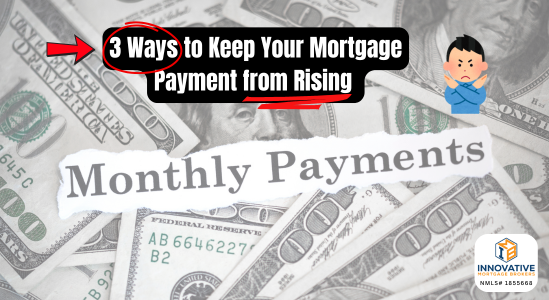3 simple ways to minimize increases even with a fixed-rate mortgage loan If you've ever…
Mortgage Recasting: Lower Your Monthly Payments without Refinancing
If you’re a homeowner looking to reduce your monthly mortgage payments without the hassle of refinancing, mortgage recasting might be the perfect solution for you. It’s a lesser-known strategy that can provide significant financial benefits, and understanding how it works can help you decide if it’s the right move for your situation.
What is Mortgage Recasting?
Mortgage recasting, also known as re-amortization, is a process that allows you to lower your monthly mortgage payments by making a large, one-time payment toward your principal balance. Unlike refinancing, recasting doesn’t change your interest rate or loan term; instead, it recalculates your mortgage based on the new, lower principal balance.
How Does It Work?
Here’s a step-by-step breakdown of how mortgage recasting works:
- Make a Lump-Sum Payment: You make a significant one-time payment toward your mortgage principal. This payment is usually in the range of $5,000 or more, but the exact amount required can vary depending on your lender.
- Recalculate Payments: Your lender will then recalculate your monthly payments based on the new, lower principal balance. This means your payments will be smaller, but your interest rate and loan term remain unchanged.
- Pay a Recasting Fee: There’s typically a fee associated with mortgage recasting, often ranging from $250 to $500. This fee is much lower than the costs associated with refinancing.
Benefits of Mortgage Recasting
Mortgage recasting offers several advantages:
- Lower Monthly Payments: The most significant benefit is the reduction in your monthly mortgage payments, which can free up cash for other expenses or investments.
- Save on Interest: By reducing your principal balance, you’ll also pay less in interest over the life of your loan, potentially saving you thousands of dollars.
- Avoid Refinancing Hassles: Unlike refinancing, recasting doesn’t require a credit check, appraisal, or extensive paperwork, making it a much simpler process.
- Retain Current Loan Terms: Since your interest rate and loan term remain the same, you avoid the risk of potentially higher rates or extended loan periods.
Is Mortgage Recasting Right for You?
Mortgage recasting can be a smart financial move, but it’s not for everyone. Here are a few scenarios where it might be particularly beneficial:
- Windfall Situations: If you’ve come into a significant amount of money, such as from a bonus, inheritance, or the sale of another property, using it to recast your mortgage can be a wise way to reduce your monthly expenses.
- Long-Term Homeowners: If you plan to stay in your home for the long haul, recasting can make your mortgage more manageable and free up funds for other investments or savings.
- Those with High-Interest Rates: If current interest rates are higher than your mortgage rate, refinancing might not make sense. Recasting allows you to keep your favorable rate while still reducing your payments.
How to Get Started
If you’re considering mortgage recasting, start by reaching out to your lender to see if they offer this option and what their specific requirements are. Discuss your financial goals and ensure that recasting aligns with your long-term plans. Here’s a step-by-step guide to help you get started:
- Contact Your Lender: Not all lenders offer mortgage recasting, so your first step is to check with your mortgage servicer. They can provide information on their specific requirements and the process involved.
- Assess Your Finances: Before making a lump-sum payment, evaluate your financial situation. Ensure that you have sufficient funds set aside for emergencies and other financial goals.
- Calculate Potential Savings: Use online mortgage calculators to estimate how much you could save in monthly payments and overall interest by recasting your mortgage.
- Make the Payment: If you decide to proceed, make the lump-sum payment as specified by your lender. Ensure you understand the recasting fee and any other associated costs.
- Review New Payment Schedule: Once the payment is processed, your lender will provide a new payment schedule reflecting your reduced monthly payments. Review this carefully to ensure everything is accurate.
Real-Life Examples of Mortgage Recasting
Let’s look at a few scenarios where homeowners benefited from this financial strategy:
Case Study 1: Family #1 in PA
They recently received a $50,000 inheritance and decided to use it to recast their mortgage. Before recasting, their mortgage balance was $300,000 with a 4% interest rate and a remaining term of 25 years. By making the $50,000 lump-sum payment, they reduced their principal to $250,000. This lowered their monthly payments from $1,584 to $1,320, saving them $264 each month.
Case Study 2: Family #2 in PA
They sold a second property and used $20,000 of the proceeds to recast their primary mortgage. The original mortgage balance was $180,000 at a 3.75% interest rate with 20 years remaining. After recasting, her principal dropped to $160,000, reducing her monthly payments from $1,063 to $949, saving her $114 per month.
Common Misconceptions About Mortgage Recasting
There are a few misconceptions about mortgage recasting that are important to address:
- “It’s the same as refinancing.” Recasting and refinancing are completely different. Refinancing involves obtaining a new loan with new terms, which can include different interest rates and loan periods, as well as closing costs. Recasting simply adjusts your current loan’s payment schedule based on a lower principal balance, while the term and interest rate remain the same as before.
- “It affects your credit score.” Unlike refinancing, mortgage recasting should not involve a credit check, so it won’t impact your credit score.
- “It’s expensive.” The fees associated with mortgage recasting are typically much lower than those for refinancing, making it a cost-effective option for lowering your monthly payments.
About Us
At Innovative Mortgage Brokers, we pride ourselves on providing personalized mortgage solutions tailored to your unique financial situation. With many years of experience, we specialize in helping clients obtain residential mortgages (1-4 units) faster, easier, and more affordably. Our services include conventional loans, FHA, USDA, and Non-QM loans. Whether you’re a first-time homebuyer, an investor, or looking to upgrade your current home, we have loan options to assist you at extremely competitive rates, and minimal fees.
Our team is committed to making the mortgage process as straightforward and stress-free as possible. We believe in clear communication and education, ensuring you understand all your options and feel confident in your decisions. Based in Philadelphia, we serve clients throughout Pennsylvania and Florida, offering competitive rates and exceptional customer service. Whether you’re considering refinancing, or purchasing a new home, we’re here to help.
Conclusion
Mortgage recasting is a valuable tool that can help you manage your mortgage more effectively. By making a lump-sum payment toward your principal, you can reduce your monthly payments and save on interest without the hassle of refinancing. If you’re in a position to make a significant payment toward your mortgage, recasting might be the perfect way to achieve greater financial flexibility and peace of mind.
Remember, every homeowner’s situation is unique, so it’s essential to consider all your options and consult with a mortgage professional to determine the best strategy for you. By understanding the ins and outs of mortgage recasting, you can make informed decisions that benefit your financial future.





